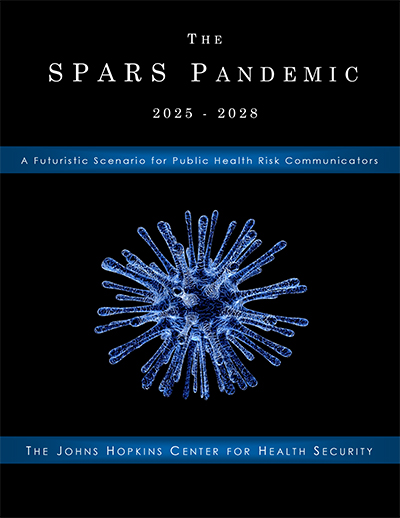Center for Health Security releases risk communications exercise scenario focused on medical countermeasures in a pandemic
Self-guided tabletop training experience challenges public health communicators and risk communication researchers to consider the complex messaging dilemmas of a future outbreak that requires development of a new vaccine
Center News

October 23, 2017 – The Johns Hopkins Center for Health Security has released a self-guided exercise scenario for public health communicators and risk communication researchers eager to deepen their understanding of the communication dilemmas that could arise when medical countermeasures are developed and distributed during a pandemic.
The SPARS Scenario features an outbreak of the novel SPARS coronavirus first identified in a major US city in 2025. Over a 3-year period, the virus spreads to every US state and more than 40 countries, where case fatality rates vary depending on the capabilities of local health systems. In the United States, an existing drug is repurposed to treat SPARS symptoms while federal regulators work with a pharmaceutical company to fast-track the production of a SPARS vaccine. The response differs in other nations. What follows is a nationwide vaccination effort and lingering strains on the US healthcare sector from a steady stream of patients seeking treatment for serious post-SPARS complications.
Scenario participants are challenged with a raft of communication dilemmas that stem from this storyline. Action items cover risk communications, rumor control, interagency message coordination and consistency, issue management, proactive and reactive media relations, cultural competency, and ethical concerns.
“This rigorous, simulated health emergency affords practitioners and scholars the opportunity to mentally rehearse responses while also weighing the implications of their actions,” said Monica Schoch-Spana, PhD, senior associate at the Center and SPARS project lead. “At the same time, readers have a chance to discern what potential measures implemented in today’s environment might avert comparable communication dilemmas or classes of dilemmas in the future.”
Schoch-Spana’s team included scenario lead authors Matthew Shearer, MPH, senior analyst at the Center, and Emily Brunson, PhD, associate professor of anthropology at Texas State University, along with contributing Center authors Sanjana Ravi, MPH, senior analyst; senior associates Tara Kirk Sell, PhD, MA, and Gigi Kwik Gronvall, PhD; and Hannah Chandler, research assistant.
To ensure that the scenario accounts for rapid technological innovation and exceeds the expectations of participants, the Center’s project team gleaned information from subject matter experts, historical accounts of past medical countermeasure crises, contemporary media reports, and scholarly literature in sociology, emergency preparedness, health education, and risk and crisis communication.
“We are thrilled to make this valuable tool available to anyone committed to strengthening crisis and risk communications strategies in the public health field,” said Schoch-Spana.
The scenario concludes with a brief section on the communication dilemmas likely to emerge during incident recovery.
About the Johns Hopkins Center for Health Security:
The Johns Hopkins Center for Health Security works to protect people from epidemics and disasters and build resilient communities through innovative scholarship, engagement, and research that strengthens the organizations, systems, policies, and programs essential to preventing and responding to public health crises. The Center is part of the Johns Hopkins Bloomberg School of Public Health and is located in Baltimore, MD.
